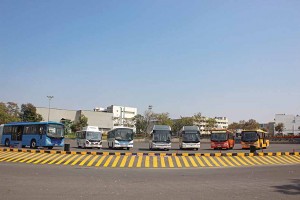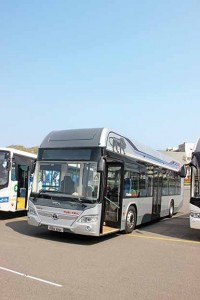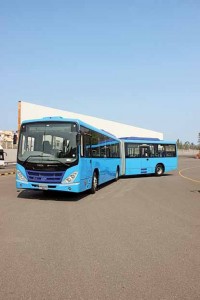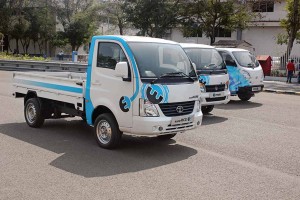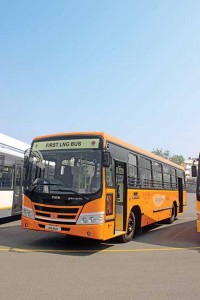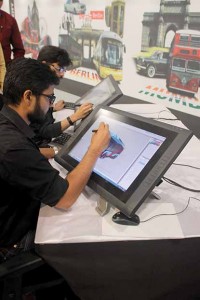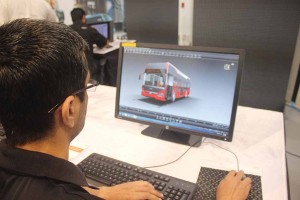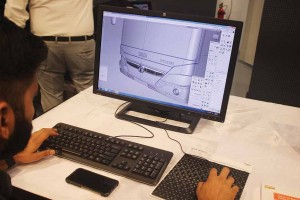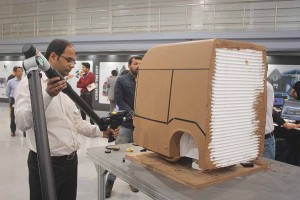The display of people movers by Tata Motors at its Pune plant provided an opportunity to gaze into the future of public transportation mediums.
Story & photos: Ashish Bhatia
To gaze into the future is not easy. To gaze into the future of technology that will influence the transportation of masses is not easy. Tata Motors, at its Pune plant, provided an opportunity to look some of the most exciting buses that will define the future modes of transportation recently. It displayed its people mover range, starting from the alternate fuel Ace Magic to the flagship Starbus fuel cell bus concept. Guenter Butschek, CEO and Managing Director, Tata Motors, announced the launch of the Starbus Hybrid city bus on the occasion. A series hybrid city bus, modelled closely on the 10 Tata CNG hybrid city buses that are running on a route in Madrid, the capital city of Spain, the Starbus Hybrid will soon hit the roads of Mumbai, at the Bandra-Kurla Complex. They will ply between BKC and the nearby suburban rail stations of Sion, Kurla and Bandra. The Mumbai Metropolitan Region Development Authority (MMRDA) has placed an order of 25 hybrid buses with Tata Motors under the FAME program. These buses will be operated by BEST. With the municipal elections in Mumbai drawing close, the first Starbus Hybrid, is expected to hit the BKC roads only after the elections are held and a new governing body comes to power.
For a democratic country like India, that is the second most populous in the world, and spread over an area of 3.287 million sq. km, the need is to move people in a manner that is well integrated. To ensure an integrated and efficient travel is a challenge. In his inaugural speech at the Busworld 2015, P S Ananda Rao, Executive Director, ASRTU, expressed the need to inculcat one-million busses immediately in addition to 7.5 lakh buses present (in the system) to address the need for people in the vast country to move. Highlighting the potential for rural connectivity, he mentioned that there is a need for 50,854 buses at 600 buses per 10 million rural population. According to a survey, claimed to be conducted by the government, over 50 per cent of the workforce continues to work at home or travel to their workplace by foot in the absence of adequate transport facilities. Many are largely dependent on private transport as the share of public transport is just 18.1 per cent of work trips. The data collected by the survey indicates that citizens are largely dependent on private modes of transport, such as bicycles (26.3 million) and motorcycles (25.4 million) in rural and urban India. In 2015 the number of daily trips using a motorcycle for commuting was 35 million (excluding personal trips).
Fuel cell bus
With a typical city bus expected to do 200 runs a day, it made for an interesting display of six most modern buses by Tata Motors including the BKC-bound Starbus Hybrid. All five buses were prototypes, and provided an opportunity to gaze into the future. The most interesting was the ‘Tata Starbus Fuel Cell bus’. This bus is said to be the country’s first ‘Fuel Cell’ bus. Touted as a zero emission mass transport solution for city travel, it was developed in partnership with ISRO (Indian Space Research Organisation), and combines hydrogen gas and oxygen. The bus measures 12 m in length and is claimed to have a power output of 114 bhp. If the use of fuel cell technology results in 40-60 per cent efficiency in energy conversion over conventional diesel buses, the bus, based on the previous-generation LPO 1625 Starbus Fuel Cell bus concept, shares the platform with the Starbus Hybrid and Starbus Electric. Four hydrogen cylinders of 205 litre capacity each are placed in the roof casing. A longitudinally arranged hydrogen fuel cell power system at the rear produces electric energy (equivalent to 114 hp) via the Lithium-ion battery pack. The battery delivers power to a rear-axle mounted propulsion motor through a summation gearbox, resulting in a combined output of 250 hp and 1,050 Nm of torque at 800 rpm. Featuring independent pneumatic suspension with hydraulic double-acting telescopic shock absorbers, the fuel cell bus features pneumatic dual-circuit s-cam braking system, which is ABS assisted. The full low-floor bus can seat 30 passengers in air-conditioned comfort. Top speed is 70 kmph, and maximum gradeability is 17 percent.
Vestibule bus
The Tata Marcopolo urban 9/18 FE vestibule bus measures 18 m in length. It can carry 120 (including 50 seated) passengers, which is almost equivalent of two 12 m buses. Powering this bus is a Cummins 6.7-litre, 280 hp engine located at the front. Aimed at moving more people in less space (in a typical urban landscape), the vestibule bus has a compact turn circle and can be manoeuvred with ease. The turning radius of this bus is claimed to be no different than a regular bus. What makes the vestibule bus significant is the order Tata Motors bagged recently to supply 30 vestibule buses for the BRT corridor at Dharwad-Hubli. Each bus is said to cost Rs.1.6 crore, and will ply on a 22.2 km-long corridor.
Mini people movers
Standing out of the crowd of buses, the electric Super Ace, Magic and Magic Iris made for a portfolio of mini people movers that Tata Motors is working on. Albeit in an electric form, they are looked upon to play the role of a feeder vehicle and last mile transporter. Already a word in last mile connectivity, the electric forms of Super Ace, Magic and Magic Iris could well set a precedent in last mile connectivity for others to follow. Powering the Super Ace electric is a permanent magnet AC motor. Electricity is fed by a 20.7 kWh lithium-ion battery. The top speed of the CV is 80 kmph. The travel range is in the region of 100 kmph, and the rated payload is 600 kg against a GVW of 1750 kg. Magic electric contains 12.6 volt, 180 Ah batteries. Equipped with regenerative braking tech, the vehicle has a power rating of 15kW. It can reach a top speed of 40 kmph, and cover a distance of 50 km on a single charge. Battery takes eight to 12 hours to charge. The Magic Iris is powered by lithium-ion battery modules of 48 volt and 110 Ah capacity. Capable of ferrying four passengers, the traction motor of the Magic Iris is rated at 9 kW. Peak torque is 42 Nm. Capable of travelling 100 km on a single charge, the two battery modules of Magic Iris take eight hours to charge fully. The vehicle can be had with a 120 watt solar panel on the roof for supplementary charging, making it a first of its kind in its segment.
LNG bus
It was late last year that Tata Motors showcased a LNG (Liquefied Natural Gas) powered city bus based on its LPO1613 platform at Thiruvananthapuram, Kerala. It did so in association with Petronet LNG Limited (PLL) and Indian Oil Corporation Ltd. Displayed here, the bus, painted in an attractive shade of orange, was powered by a 5.7-litre BSIV engine that produces 130 hp of peak power at 2500 rpm and a peak torque of 405 Nm at 1250-1500 rpm. The LPO1613 chassis is built at the Lucknow plant, and the body is built at Marcopolo’s Dharwad plant. Dr. A K Jindal, Head – Engineering Research Centre, Commercial Vehicles, Tata Motors, expressed that Kerala is keen to place an order for 10,000 buses, with 10 per cent of them, LNG powered. He added, “The supply constraints posed by CNG infrastructure makes LNG a logical extension. To increase the range of a CNG powered bus (from 300 km), more storage cylinders will be needed. This will adversely affect the power to weight ratio, payload capacity and seating capacity. LNG has a two-and-a-half times more per litre capacity than diesel. The range therefore will be between 600 to 700 km.” RT Wasan, Vice President – Sales and Marketing, Tata Motors, mentioned that cities are growing, leading to traffic congestion, in-turn bringing out a need to design different modes of public transportation. “The Urbanisation in India is skewed as compared to countries like China,” he added.
Buses for a greener tomorrow
As countries the world over seek greener ways of move people, putting impetus on alternate mediums of propulsion, it did not come as a surprise when Dr. Jindal stated that, there is a need to adopt a viable combination of fuel and vehicle technology. Stressing upon rapid urbanisation, Wasan said that there was a need to look at the mode of transport that would best suit the needs. This would call for lower investment in infrastructure, and relate to issues like direct health-cost of urban pollution, transport mortality, air quality, climate change and depleting natural resources, he added. With the rate of electric and hybrid technology penetration to be dictated by the pace of technological breakthrough and federal policies, it is essential to take into account a study conducted by the Ministry of Urban Development (MoUD), which projected average speeds across cities are falling. Said Wasan, “The government’s approach to building more roads looks contradictory to the need for facilitating an eco-system where sustained mobility coexists.” Wasan cited the example of Jakarta, the most populous city of Indonesia. He explained, “Families traveling in private vehicles are charged a levy for using the infrastructure. In such an instance, public transport provides the answers.” Ravi Pisharody, Executive Director – Commercial Vehicles, Tata Motors, expressed that December sales figures are a testimony to buses doing well. “We are doing well in buses,” he added. Pointing at State Transport Undertakings (STUs), Pisharody stated, “Buying is coming back and a lot of tenders are being floated as we speak. It is after a long time that buses have come into a space they deserve. The Indian economy does not support them.” Announced Butschek that the company’s aspiration is to be among the top three global CV players by FY2018-19. “The objective is to transform the Indian commercial vehicle landscape, and to offer the customers cutting edge auto technologies, packaged for superior performance and low lifecycle costs,” added Butschek.
Gazing into the future
Taking a holistic view, and as far as the application of technology is concerned, Dr. Jindal said that the reduction in battery costs is a positive sign. “Electrification does make an ideal choice for long haul or for heavy-duty application. The technology model is simply unsustainable, and would eat into the vehicle payload,” he mentioned. Electromobility, according to Dr. Jindal is suitable for vehicles that travel over shorter distances. Hybridisation, he added, is suitable for a medium-duty vehicle that travels over a medium distance. While the lifecycle cost is lowest in hybrid and electric vehicles, the major challenge for operators is the acquisition cost. It is two-to-three times higher than conventionally powered vehicles. A ray of hope according to Dr. Jindal, is if the government intervenes to make it feasible for new technology to embed itself sooner than later. Driving a frugal strategy, technology development at Tata Motors spans across diverse areas like vehicle control strategy, electric and hybrid vehicle battery development, traction system development, high voltage components and safety, Noise, Vibration and Harshness (NVH), durability testing, light weighting, and customer trials. A part of the strategy is also to build key components in-house. Fast charging batteries are being worked upon by using Lithium Titanate Oxide (LTO) technology. According to Dr. Jindal, the advantages of LTO are significant. This battery technology is considered to be a game changer. Working on a future ready product pipeline, Tata Motors, said Dr. Jindal, has already exceeded the 20 per cent fuel reduction target set by the FAME scheme of the Government of India towards encouraging electric vehicles. “ The need of the hour is to achieve a sustainable hub and spoke public transportation model for new technology mediums to find a place and grow,” signed off Dr. Jindal.
The art of designing
In what could be a rare occasion, Tata Motors provided an opportunity to peep into its design studio at Pune. It is the nerve centre, which brings a CV to life. A visual rendering undergoes several reiterations in a bid to refine the final layout of the vehicle before going into production. The entire process of the development of Starbus Hybrid was shown at the studio in steps that revealed the journey from the drawing board to a production model. Step one showed how the primary sketch of the bus was turned into a more definitive form. In consultation with different verticals at the OEM, it was further refined. The bis turned two dimensional. The next step saw the two dimensional form being shared with the three dimensional modelers to achieve a full scale three dimension model. This process, includes consulting the engineering team to work on areas like manufacturing, production and other. It is at this step that the creative team and the technical team come together. The rendered form begins acquiring details. Step three involves building a dummy model, which is handed over to the clay modelers. The clay modelers refine the surface. Stage four involves the task of transforming the clay model into data using a laser beam and camera based equipment. Refined surfaces are accurately captured. Controlling the hardware is Pollyworks’ software. Scans are transferred to a Complex Adaptive System (CAS) modeller. It is then sent to a Computer Numerical Control (CNC) machine to replicate the image of the model. The design process further evolves with the help of a Computer Aided Design (CAD) and Computer Aided Manufacturing (CAM). CAD is three-dimensional in a bid to bring more details on to the ideated sketch. Designers are encouraged to carry out an in-depth field research on public transportation in the country before they ideate a new concept. Designers also ensure that the new elements merge seamlessly with the standard design elements. This ensures that the result is in sync with the brand identity.



